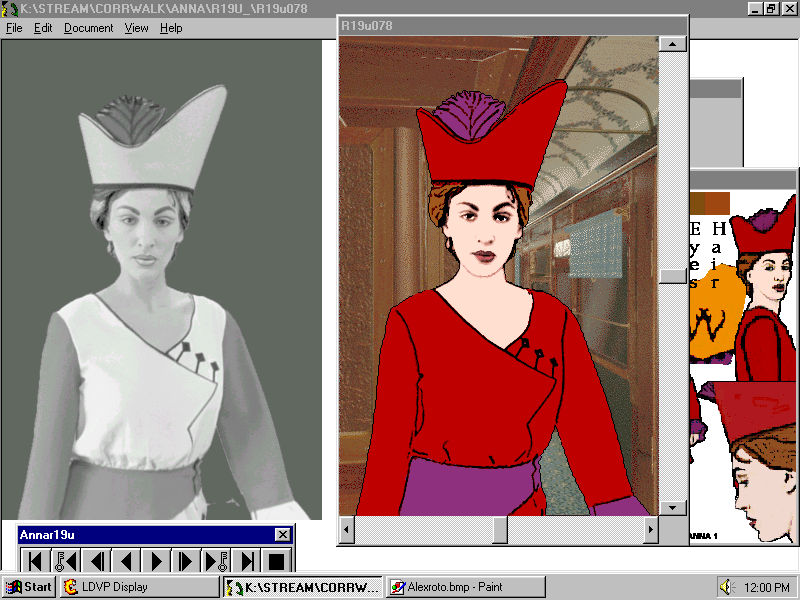98
The feeling of immediacy in Myst, as in other games of this genre, is generated in large part by the player's expectations derived from the medium of film. It is not really as if the player were on Myst island, which after all looks like no island on earth; it is as if the player were in a film about Myst island. The game can only attempt to satisfy the viewer's desire for immediacy by seeming to put her in a film. Her sense of immediacy comes only through an awareness of mediation.
Myst is by no means the only example of a computer game that remediates film, although it is unusually resonant with the history of film.
The feeling of immediacy in Myst, as in other games of this genre, is generated in large part by the player's expectations derived from the medium of film. It is not really as if the player were on Myst island, which after all looks like no island on earth; it is as if the player were in a film about Myst island. The game can only attempt to satisfy the viewer's desire for immediacy by seeming to put her in a film. Her sense of immediacy comes only through an awareness of mediation.
Myst is by no means the only example of a computer game that remediates film, although it is unusually resonant with the history of film.
Myst's sequel, Riven, appears to reiterate the strategy of the first game, employing the same interface of pointing and clicking through static images (and in some cases video). But the images are more photorealistic and the game in general is even more calculated in its pursuit of immediacy.
Myst's sequel, Riven, appears to reiterate the strategy of the first game, employing the same interface of pointing and clicking through static images (and in some cases video). But the images are more photorealistic and the game in general is even more calculated in its pursuit of immediacy.
We might also have examined The Last Express, which is more overtly filmic than Myst or Riven. Although the characters and backgrounds are graphic stills and animations (in some cases generated from filmed figures by motion capture), the mise-en-scène and the "camera shots" are entirely consistent with the Hollywood style. The player clearly feels herself to be in a film-as usual, a film of mystery or detection. The plot recalls Hitchcock or Graham Greene: the player is given the role of an American expatriate who must assume the identity of his friend aboard the Orient Express on the eve of World War I. At the beginning, the American character knows nothing about the plot in which he is implicated with the discovery of his friend's murder. In typical Hitchcock fashion, he must learn more while avoiding arrest by the police and whatever danger killed his friend. He must learn in real time as the train moves across Europe-by walking up and down the corridors, meeting people who seem to know him, and eaves- dropping on conversations that may provide useful information. One of the most compelling features of The Last Express is the way in which a filmic sense of plot is integrated with the monitoring function that computer games have in common with television.
We might also have examined The Last Express, which is more overtly filmic than Myst or Riven. Although the characters and backgrounds are graphic stills and animations (in some cases generated from filmed figures by motion capture), the mise-en-scène and the "camera shots" are entirely consistent with the Hollywood style. The player clearly feels herself to be in a film-as usual, a film of mystery or detection. The plot recalls Hitchcock or Graham Greene: the player is given the role of an American expatriate who must assume the identity of his friend aboard the Orient Express on the eve of World War I. At the beginning, the American character knows nothing about the plot in which he is implicated with the discovery of his friend's murder. In typical Hitchcock fashion, he must learn more while avoiding arrest by the police and whatever danger killed his friend. He must learn in real time as the train moves across Europe-by walking up and down the corridors, meeting people who seem to know him, and eaves- dropping on conversations that may provide useful information. One of the most compelling features of The Last Express is the way in which a filmic sense of plot is integrated with the monitoring function that computer games have in common with television.
Star Trek: Borg : The interactive movie
Author: Simon & Schuster
Year: 1996 Edit Add
Book: Remediation
Star Trek: Borg : The interactive movie
Author: Simon & SchusterYear: 1996 Edit Add
Book: Remediation
Others string together segments of live- action film, as does Star Trek Borg: The interactive Movie, which is shot entirely from the first-person point of view of the player as a character.
Others string together segments of live- action film, as does Star Trek Borg: The interactive Movie, which is shot entirely from the first-person point of view of the player as a character.
 Source type: picture
Source type: pictureInfo: Star Trek Borg: The interactive Movie (1996)
Original size: 1216x910 px. Edit
 Source type: picture
Source type: pictureInfo: Star Trek Borg: The interactive Movie (1996)
Original size: 1218x910 px. Edit
 Log-in
Log-in Source type: picture
Source type: picture Source type: picture
Source type: picture Source type: picture
Source type: picture Source type: picture
Source type: picture Source type: picture
Source type: picture